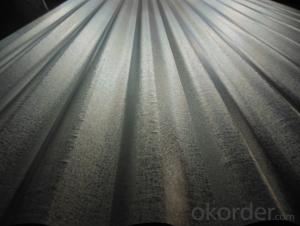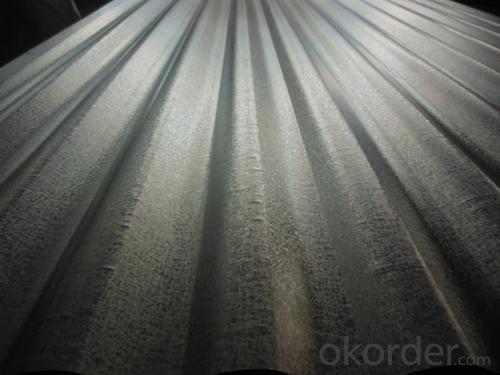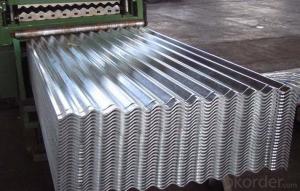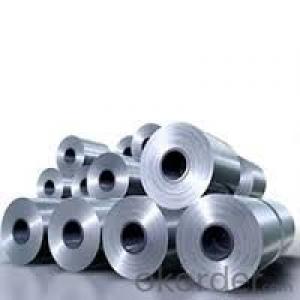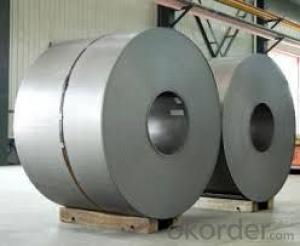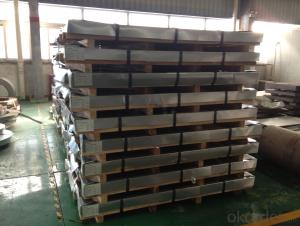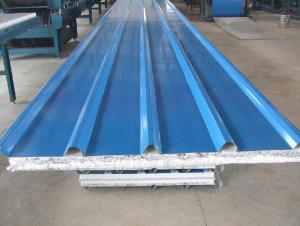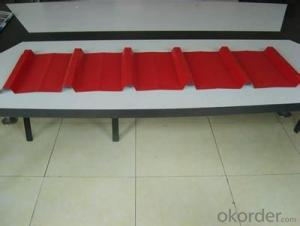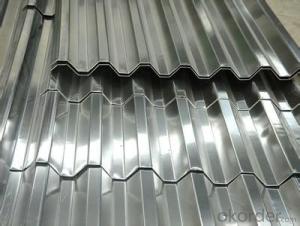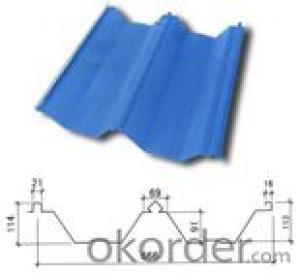Aluzinc Corrugated Steel Sheet
- Loading Port:
- China Main Port
- Payment Terms:
- TT OR LC
- Min Order Qty:
- -
- Supply Capability:
- -
OKorder Service Pledge
OKorder Financial Service
You Might Also Like
Aluzinc Steel AFP Details:
| Minimum Order Quantity: | 25mt | Unit: | m.t. | Loading Port: | China Main Port |
| Supply Ability: | 50000 Metric Tons per Month | Payment Terms: | T/T or L/C |
Product Description:
General Information
Thickness: 0.25mm-4.0mm |
Width: 900mm-1250mm |
Alu-zinc Coating: 50-150g/m2 |
Internal Diameter: 508mm/610mm |
Coil Weight: 4-8MT |
Quality: commercial and structural quality |
Surface Treatment: oiled & dry, chromated, anti-finger, non-skin pass/ skin pass |
Standard: JIS G 3321, ASTM A792M, EN 10215 |
Steel Grade: SGCC, SGCD, CS,FS,SS,DX51D+Z DX52D+Z; S200GD, S220GD, S280GD, S350GD |
Package: full wrapped with anti-damped paper inside, iron sheet wrapped outside, and bundled by iron strips |
Technical Data
Chemical Composition | C | Si | Mn | P | S |
0.04-0.06% | 0.01-0.03% | 0.18-0.22% | 0.014-0.016% | 0.006%-0.009% |
Technical Data | |
Yield Strength | (Mpa) 280-320 |
Tensile Strength | (Mpa) 340-390 |
Elongation | 20%-30% |
Out-of-square | not exceed 1% Flatness |
Bow | 15mmmax |
Edge Wave | 9mmmax |
Centre Buckle | 8mmmax |
Bending At 180 Degree | no crack, peeling and fraction |
Application
Aluzinc Steel can be widely used in transportation, light industry, civil usage and farming. It is also the perfect building material in construction for making roofing tile, steel profiles for wall partition, T-bar, studs, fireproof door, air conditioning duct and home appliance.
- Q: What are the different surface finishes available for steel sheets?
- There are several different surface finishes available for steel sheets, including hot rolled, cold rolled, galvanized, coated, and brushed finishes.
- Q: Are steel sheets suitable for food storage applications?
- Yes, steel sheets are highly suitable for food storage applications. They are durable, resistant to corrosion, and provide a hygienic and safe storage environment for food products. Steel sheets can maintain the freshness and quality of food while protecting it from external contaminants.
- Q: How is the weight of the steel plate calculated?
- Steel plate is made of molten steel, cooled and compressed into flat steel.The steel plate is flat, rectangular, and can be rolled directly or cut from a wide strip of steel.
- Q: Can steel sheets be used for transportation equipment?
- Yes, steel sheets can be used for transportation equipment. Steel is commonly used in the automotive industry for manufacturing various components such as body panels, frames, chassis, and other structural parts due to its high strength, durability, and impact resistance. It is also utilized in the production of trains, ships, and aircraft, making it a versatile material for transportation equipment.
- Q: How do steel sheets perform in terms of load-bearing capacity?
- Steel sheets have excellent load-bearing capacity. Due to their high tensile strength and durability, they can effectively support heavy loads without bending or breaking.
- Q: Can steel sheets be used for agricultural buildings or barns?
- Yes, steel sheets can be used for agricultural buildings or barns. Steel sheets offer numerous advantages for these types of structures. Firstly, steel is a durable and long-lasting material, ensuring that the agricultural building or barn will be able to withstand the test of time and various weather conditions. Steel is also resistant to pests such as termites, which can be a common problem in wooden structures. Additionally, steel sheets are fire-resistant, providing an added layer of safety. Moreover, steel sheets are highly customizable, allowing for flexibility in design and construction. They can be easily cut and shaped to fit the specific needs and requirements of the agricultural building or barn. Steel sheets are available in various thicknesses, providing options for different levels of strength and structural integrity. Furthermore, steel is an environmentally friendly choice for agricultural buildings or barns. It is a recyclable material, meaning that at the end of its lifespan, it can be repurposed and reused, reducing waste and minimizing the environmental impact. Considering all these factors, steel sheets are a great choice for agricultural buildings or barns due to their durability, pest resistance, fire resistance, customizability, and environmental friendliness.
- Q: How do steel sheets perform in seismic zones?
- Steel sheets perform well in seismic zones due to their inherent strength and ductility. The flexibility and high tensile strength of steel allow it to absorb and dissipate the energy generated during seismic events such as earthquakes. This helps to minimize damage and maintain the structural integrity of buildings and other structures. Steel sheets are commonly used in seismic design and construction because they offer several advantages. Firstly, steel is a lightweight material, which reduces the overall weight of the structure and allows for more efficient seismic design. Additionally, steel sheets can be easily fabricated and assembled, making the construction process faster and more cost-effective. In seismic zones, steel sheets are often used in the form of shear walls or bracing systems. These elements are strategically placed throughout the building to provide lateral stability and resist the forces generated by earthquakes. Steel sheets can also be used as a cladding material, providing an additional layer of protection against seismic forces. Moreover, steel has excellent fire resistance properties, which further enhances its performance in seismic zones. In the event of a fire, steel sheets retain their structural integrity for a longer duration compared to other materials, ensuring the safety of occupants and reducing the risk of collapse. Overall, steel sheets are a reliable and effective choice for construction in seismic zones. Their strength, ductility, lightweight nature, ease of fabrication, and fire resistance make them an ideal material for ensuring the safety and stability of structures during seismic events.
- Q: What is the typical thickness tolerance for steel sheets?
- The steel sheet thickness tolerance can vary depending on the specific industry and application requirements. Different industries or applications may have more stringent tolerance requirements, especially when precision is crucial. In such cases, the tolerance may be tighter. Specialized steel products or specific customer requirements may also lead to different tolerance specifications. Manufacturers employ strict quality control measures to ensure compliance with the desired thickness tolerance. These measures include precise calibration of equipment, regular inspection of raw materials, and comprehensive testing procedures. This helps maintain the integrity and reliability of steel sheets for various applications in industries such as automotive, construction, manufacturing, and more.
- Q: What is the difference between hot rolled and cold rolled steel sheets?
- The main difference between hot rolled and cold rolled steel sheets lies in the production process. Hot rolled steel sheets are manufactured at high temperatures, which results in a rougher surface and less precise dimensions. In contrast, cold rolled steel sheets are processed at lower temperatures and undergo additional rolling, resulting in a smoother surface finish and more accurate dimensions.
- Q: Are steel sheets suitable for electrical transformer cores?
- Steel sheets are an appropriate choice for electrical transformer cores. They are widely utilized in transformer cores because of their magnetic characteristics and their ability to effectively conduct magnetic flux. The steel sheets used in transformer cores are typically made from top-quality electrical steel, also known as silicon steel or transformer steel. This specific type of steel demonstrates low core losses and high magnetic permeability, which make it an optimal selection for transformer applications. The structure of the steel sheets, which is made up of laminations, aids in reducing eddy current losses by establishing a path of high electrical resistance. These sheets are also coated with an insulating varnish to further minimize eddy current losses and prevent electrical short circuits. The laminations are then assembled together to form the core, creating a path of low reluctance for the magnetic field generated by the transformer's primary winding. The incorporation of steel sheets in transformer cores ensures efficient energy transfer by minimizing energy losses. The magnetic properties of steel contribute to the transformation and regulation of electrical power, allowing transformers to increase or decrease voltage levels while maintaining high efficiency. Moreover, steel sheets possess exceptional mechanical strength and stability, which guarantees the long-term durability of transformer cores. In conclusion, steel sheets are highly suitable for electrical transformer cores due to their magnetic properties, low core losses, high magnetic permeability, and mechanical strength. These properties facilitate efficient energy transfer, voltage regulation, and long-term reliability in transformer applications.
Send your message to us
Aluzinc Corrugated Steel Sheet
- Loading Port:
- China Main Port
- Payment Terms:
- TT OR LC
- Min Order Qty:
- -
- Supply Capability:
- -
OKorder Service Pledge
OKorder Financial Service
Similar products
Hot products
Hot Searches
Related keywords
